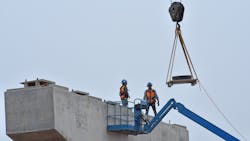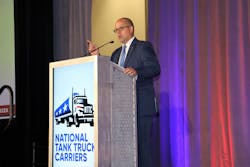Biggest infrastructure spending bill in history heads to president’s desk
A bipartisan vote in the House late last week passed the largest infrastructure spending bill in history, securing a $1.2 trillion package to improve U.S. highways, bridges, and ports that had failed to get much legislative attention this century.
National Tank Truck Carriers president and CEO Ryan Streblow wholeheartedly approves.
The association quickly congratulated Congress on the passage of the Infrastructure Investment and Jobs Act, saying it is “pleased” there will be long-term investments through the 2026 fiscal year to enhance safety, maintenance, and planning programs for the transportation infrastructure used by tank trucks carrying essential commodities.
“Congress’ passage of surface transportation reauthorization has been long-awaited for our industry and a victory for all Americans,” Streblow said. “We depend on safe, efficient, and reliable transportation networks to connect our country seamlessly. The Infrastructure Investment and Jobs Act is an investment not only in roads and bridge safety, but it is an investment in the people and tools needed to move the essential commodities of the future.
“NTTC applauds Congress for its work to pass this legislation, and NTTC will continue to work with Federal partners to address the freight movement challenges of today and tomorrow.”
Months after a bipartisan group of U.S. senators hammered out details on the bill and passed it over the summer, the House needed some Republican votes to get the measure to President Biden’s desk, where he’s expected to sign the bill into law after Congress reconvenes next week. Democrats had hoped to pass the infrastructure bill along with a separate $2 trillion proposal aimed at health care, climate, immigration, and tax laws. But that second bill was not finalized last week—as various factions of congressional Democrats continue to debate its details.
A bipartisan group of Democrats and 13 Republicans came together to vote for the hard infrastructure bill, which passed just before midnight on Nov. 5, handing the president a landmark piece of legislation that has a lot to say about the trucking and commercial transportation industry. The 2,700-page bill focuses on increased safety systems for commercial vehicles, recruiting a new, more diverse driver pool into trucking, and lots of money to fix the nation’s crumbling infrastructure.
About half of the $1.2 trillion bill includes new spending, representing the most significant infrastructure investment in U.S. history. The money approved by Congress would fix roads and bridges ($110 billion), build out a nationwide electric vehicle charging infrastructure ($7.5 billion), improve ports and waterways ($16 billion), fund public transit ($49 billion), boost freight and passenger rail ($66 billion), improve airports ($25 billion), and boost broadband internet infrastructure ($65 billion).
“Roads and bridges are not political—we all drive on them,” Chris Spear, president and CEO of the American Trucking Associations, said after the bill’s passage. “A majority in the House realized this today and did what’s right for the country, not themselves. From farmers to truckers, the millions of hard-working people who make this country great won today. Those lawmakers who put their constituents before themselves to help seal this achievement have cemented a lasting legacy that the American people will now see, feel, and use for many decades to come.”
The trucking industry has been pushing for more infrastructure spending for years—something the three previous presidents of the 21st century were unable to deliver. With more than $550 billion of the bill marked for hard infrastructure spending, the package headed to Biden’s desk represents the most significant federal spending package on roads and bridges in generations.
That spending could be good news for the trucking industry, which employs more than 8 million Americans and moves more than 70% of the country’s freight along its roads. More than 3.5 million truck drivers move that freight along the nation’s crumbling infrastructure every day. “Of the 617,000 bridges across the U.S., nearly half of those are 50 years old,” Spear said in September as the industry waited for the House to act on the measure. “And 46,000 of them are structurally deficient. Of our 4 million miles of public roads, nearly half are in poor or mediocre condition. This is embarrassing—and it’s completely unacceptable.”
While the bill includes studies and pilot programs aimed at the trucking industry, fixing roads and bridges might be the most significant benefit for the industry, according to David Heller, VP of government affairs for the Truckload Carriers Association. “That’s the one thing we desperately need,” he said while the bill was being debated this summer. “We need a fix to our infrastructure—our physical infrastructure such as roads and bridges, which is the traditional definition of infrastructure.”
There is more for trucking in the 2,700-page bill: a mandate for automatic emergency braking (AEB) systems on commercial vehicles, trailer and truck underride guard studies, driver workforce outreach programs, promoting women to work in the trucking industry, a study of truck leasing, and a pilot program to allow younger drivers to operate across state lines, among other items. (Read more details here.)
“After countless hearings and meetings on Capitol Hill, ATA members will finally see the fruits of their labor—a 38% increase in road and bridge funding, and an infusion of highly-trained, younger talent into our workforce,” Spear said last week.
Jason McDaniel contributed to this report, which first appeared on FleetOwner.
About the Author

Josh Fisher
Technology Editor
FleetOwner Editor-in-Chief Josh Fisher has been with Endeavor's Commercial Vehicle Group since 2017, covering everything from modern fleet management to operational efficiency, artificial intelligence, autonomous trucking, regulations, and emerging transportation technology. He is based in Maryland.

